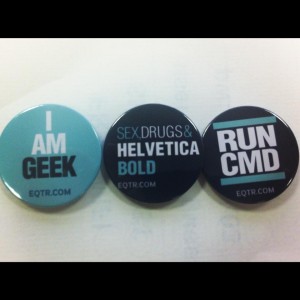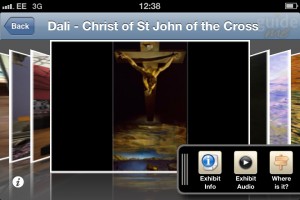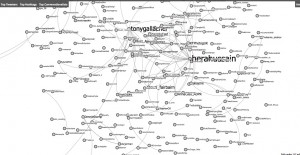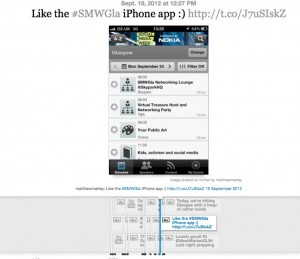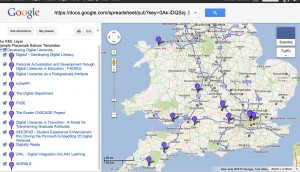On the final day of Social Media Week, I’ve been at a couple of marketing and branding sessions hosted by Equator Agency a “digitally led marketing agency” based in Glasgow. Equator have totally embraced Social Media Week Glasgow. As well running several sessions, and sponsoring the event, they are the guys behind the geek glasses and badges which I shared earlier.
It’s always nice to get out of one’s comfort zone, and be at events with different faces and perspectives on things. And this was certainly true of the “social outreach – what’s in it for me?” session. Essentially this session was an overview of how brands and bloggers can work effectively together. The presentation was very much from a brand marketing point of view. However as the session progressed, it did start to raise some questions in my mind about my own approach to not only to blogging but wider questions of innovation support and the role of JISC and JISC innovation support centres such as CETIS in developing, supporting and encouraging our blogging networks so that ideas, good practice etc are shared more widely within the HE sector. Particularly as a large part of the presentation focused on the role of blogging networks and effective brand engagement with them.
Like many of my peers I have my own personal network of blogs which I follow. It’s built up over time, is very informal, but I suspect it is very similar to other personal networks of colleagues. In turn I suspect that I am also part of a larger, informal network of edubloggers – in fact I’m probably part of several. I comment and interact with them and vice versa. In general it’s a happy, informal, serendipitous space which is great but could it be more? There are some “star” bloggers in there who have a large following, and probably don’t need any support. But there are also some other blogs, particularly project blogs which maybe could benefit from being part of a more formalised network which could give guidance and support and encourage more participation and engagement. During the session BritMums was highlighted as an example of a really effective blogging network. It has over 4,000 active bloggers, provides support and guidance to newbies, runs events to share ideas etc.
I think that with some JISC funded programmes we have probably missed a trick with in terms of really supporting project blogs. Again with some programmes/projects there has been a lot of interaction, and with some not so much. Although blogging is being seen more and more as de-facto project practice, some projects are much better at it than others. In some ways having the blog set up is sometimes seen as a project outcome in itself, and not the updating and populating content regularly bit. In terms of project support, although I do try to comment and share project blog posts, I don’t diligently read every blog post from every project (but don’t tell anyone I said that).
Again being out of “JISC world” for a large part of this week, I’ve been struck again but the lack of knowledge of all the innovation in HE that is happening in the wider world. And I know even within HE itself, a lot of the work JISC funds isn’t known about. So, as JISC moves into its next phase, and with its new focus on customer enagement would the development and support of a trusted network (written by the community for the community) of bloggers not be ideal way to a) share innovation and new practice b) build on exisiting network connections c) help share knowledge of sustainability and embedding of outcomes/outputs of funded projects d) get feedback from the ground up on what the sector would like JISC to do?
One thing the session presenter Fiona Dow, mentioned was that Equator have an ever growing database of “trusted” bloggers who they are continually communicating with, and so have a number of people to approach for various campaigns. Is a similar edublogger database something that say an innovation support centre such as CETIS should develop and maintain? Time to develop relationships with “trusted networks and bloggers” was also highlighted. So, again, should we take more time to more formally develop and share our informal blogging networks? Currently the JISC comms team sends a daily email with related press cuttings to JISC staff – should we be producing a similar email highlighting interesting blog articles from within our community?
Does this sound like something you would like to be part of ? Or should we just continue with our own informal, self forming groups? I’d be really interested to hear any views on this or any other ideas this might have triggered.
